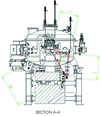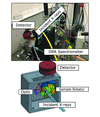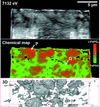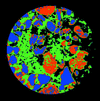issue contents
March 2020 issue

Cover illustration: Tomographic reconstruction with a Generative Adversarial Network (GANrec) (see Yang, Kahnt, Bruckner, Schropp, Fam, Becher, Grunwaldt, Sheppard and Schroer, pages 486-493). The result is reconstructed from missing-wedge data (0-120° scanning angle) of a simulation phantom.
facility information
editorial
Free 

Foreword to the virtual issue papers from the PhotonDiag2018 workshop.
research papers
Open  access
access
 access
accessA wavefront sensor for an X-ray free-electron laser has been developed using the fractional Talbot effect. This wavefront sensor enables measurements over a wide range of energies, as is common on X-ray instruments, and is compatible with the high average power pulses expected in upcoming X-ray free-electron laser upgrades.
Open  access
access
 access
accessA five-axis parallel kinematic mirror unit, with a small form factor and high stability, for use at soft X-ray synchrotron beamlines is presented.
Open  access
access
 access
accessAt MAX IV, a fourth-generation, or diffraction-limited, synchrotron light source, six soft X-ray monochromators (Bloch, Veritas, HIPPIE, SPECIES, FinEstBeAMS and SoftiMAX beamlines) are examined with a focus on their resolving power, energy range and the time required to change measurement range. When measuring the mechanical resolution defined by angular vibrations, FinEstBeAMS shows a resolving power R of better than 30000 for all studied cff values, while, for HIPPIE, the resolving power for cff = 2.25 and higher and for energies lower than 1 keV is better than 100000.
A theoretical review is provided of the X-ray near-field speckle-based phase-sensing approach and its associate processing schemes available for optics and beam characterization.
The X-ray near-field speckle-based phase-sensing approach and its associated processing schemes are illustrated experimentally in the context of optics and beam characterization.
Open  access
access
 access
accessCoherent and partially coherent accurate wavefront propagation simulations using Synchrotron Radiation Workshop (SRW) through thick two-dimensional Be compound refractive lenses are presented, taking into account the effects of phase errors obtained by X-ray speckle vectorial tracking at the BM05 Instrumentation Beamline at the ESRF.
Sub-millimetre arrays with pixel pitch less than 500 mm, based on boron oxide encapsulated vertical Bridgman grown cadmium–zinc–telluride crystals, were fabricated. Excellent room-temperature performance characterizes the detectors even at high-bias-voltage operation (9000 V cm−1) with energy resolution of 1 keV FWHM at 60 keV.
Open  access
access
 access
accessUse of the charge-integrating JUNGFRAU detector for fluorescence detection is investigated, and its applications in macromolecular crystallography at synchrotron and X-ray free-electron laser sources are demonstrated.
A new photon-counting camera based on hybrid pixel technology has been developed at the SOLEIL synchrotron; it allows the implementation of pump–probe–probe hard X-ray diffraction experiments for the first time. A benchmark experiment was successfully performed, showing the advantages of the pump–probe–probe scheme.
The development of instrumentation for conducting high-pressure resonant X-ray scattering experiments under cryogenic conditions is presented.
Open  access
access
 access
accessThe HARE chip and a toolbox of helpful instrumentation for time-resolved serial synchrotron crystallography are presented.
The development of a laser shock experiment at the PF-AR NW14A beamline is presented. Shock dynamics of polycrystalline Al has been observed by nanosecond time-resolved X-ray diffraction.
First results are presented for synchrotron radiation diffraction in a paratellurite (TeO2) single crystal investigated with a new experimental scheme consisting of a standard monochromator and a relatively narrow slit. A new method of measuring the angular position of the crystal by means of an adaptive piezoactuator is applied for the first time. The experimental curves are compared with the theoretical diffraction rocking curves of the paratellurite crystal, both theoretical and calculated taking into account the instrumental function.
Open  access
access
 access
accessFollowing the recent demonstration of the sensitivity of grazing-incidence X-ray fluorescence to the lateral structure of periodic nano-patterned devices, a computational scheme for the simulation of experimental data is presented. This can be used for the element-selective analysis of 3D atomic distributions in nano-patterned structures.
An acoustically levitated droplet has been used to collect synchrotron small-angle X-ray scattering at very high protein concentrations (>200 mg ml−1) – difficult to measure in standard flow-through cells. The data can be collected with minimal sample consumption. Details of the methodology and data treatment are shown thoroughly.
A seed-skewness algorithm for X-ray signal detection is presented and tested. This work shows that the approach works well for photocrystallographic time-resolved Laue datasets.
Open  access
access
 access
accessA portable laser-heating system, optimized for synchrotron X-ray spectroscopy, is presented.
Open  access
access
 access
accessLinear dichroism at the Ti K-edge is investigated in rutile TiO2 single crystal. A complete assignment of the pre-edge is provided based on finite difference method calculations and spherical tensor analysis. The origin of weak peak A2 similar to anatase TiO2 is discussed from the presence of oxygen vacancies or from an intrinsic quadrupolar transition.
The theoretical development and experimental validation of the ultra-fast measurement technology of temperature by extended X-ray absorption fine structure are presented.
The operation of a miniature tender X-ray spectrometer for use in X-ray emission spectroscopy and resonant inelastic X-ray scattering (RIXS) is reported. Results of several RIXS measurements on sulfur and uranium are presented and compared with prior literature.
Interatomic distances of micrometre-size particles were determined with sub-50 nm resolution by ptychography-EXAFS method.
Problems of imaging dentinal tubules using synchrotron radiation (SR) are addressed. In computer modeling of a phantom material similar to dentin, it was assumed that the radiation was coherent and that the tubules were parallel to each other. Real millimetre-sized dentin specimens have been investigated by SR microtomography when the incident radiation is not fully coherent. Tomograms were reconstructed from experimental projections using an algorithm for incoherent radiation. The directions of the tubules in a volume of the specimens were generated. However, the tubule cross-section structure cannot be restored.
Fast diffraction-enhanced imaging composed of continuous fast rotations of samples and slow scanning of analyzer crystals has been developed.
Open  access
access
 access
accessA device for mechanical milling of samples for nano-tomography is presented.
Open  access
access
 access
accessA deep-learning method for limited angle tomography in synchrotron radiation transmission X-ray microscopies and a demonstration of its application in 3D visualization of a chlorella cell.
Open  access
access
 access
accessA generative adversarial network (GAN) is used to reconstruct the missing-wedge tomographic data of an in situ ptychographic measurement.
A three-image algorithm is proposed for quantitative transmission, refraction and dark-field retrieval in hard X-ray grating interferometry. The novel algorithm is theoretically derived, and validated by proof-of-principle synchrotron radiation experiments. Furthermore, the noise properties of the three retrieved signals are investigated in terms of the standard deviations.
short communications
The presented parabolic-shaped aluminum filtration system allows to flatten the Gaussian X-ray intensity distribution produced by a bending magnet, resulting in more spatially homogeneous dose and image noise distributions, and to use a wider portion of the beam for imaging purposes.
beamlines
Open  access
access
 access
accessAn ambient-pressure photoemission spectroscopy beamline has been constructed and has recently begun regular user service at Pohang Accelerator Laboratory. This beamline is a soft X-ray beamline with undulator (U6.8) insertion device and will be a platform for operando surface science.
Open  access
access
 access
accessID15A is a newly refurbished beamline at the ESRF devoted to operando and time-resolved diffraction and imaging, total scattering and diffraction computed tomography.
Open  access
access
 access
accessA Bassett-type hydrothermal diamond-anvil cell has been modified to enable in situ X-ray diffraction measurements on liquid samples up to 5 GPa and 1300 K at the Diamond Light Source. The new experimental setup provides a maximum accessible scattering vector Qmax of 18 Å−1 (at 56 keV) for improved resolution in G(r).
Open  access
access
 access
accessA resonant inelastic X-ray scattering instrument operating in the intermediate X-ray range is described in detail. The instrument is operated at beamline P01 of the PETRA III synchrotron in Hamburg, Germany.
The development status of XANES nanoscopy on BL7C at Pohang Light Source-II (PLS-II) and an explanation of this experimental technique through analysis of the battery-material example are presented.
computer programs
Open  access
access
 access
accessA high-throughput program for the processing of QEXAFS spectra is presented.
Open  access
access
 access
accessNew tools to calibrate different types of scattering experiments suitable for static and moving detectors are presented.
A new spectroscopy analysis package that is optimized for 2D X-ray absorption near-edge spectroscopy is presented.


 journal menu
journal menu





























































